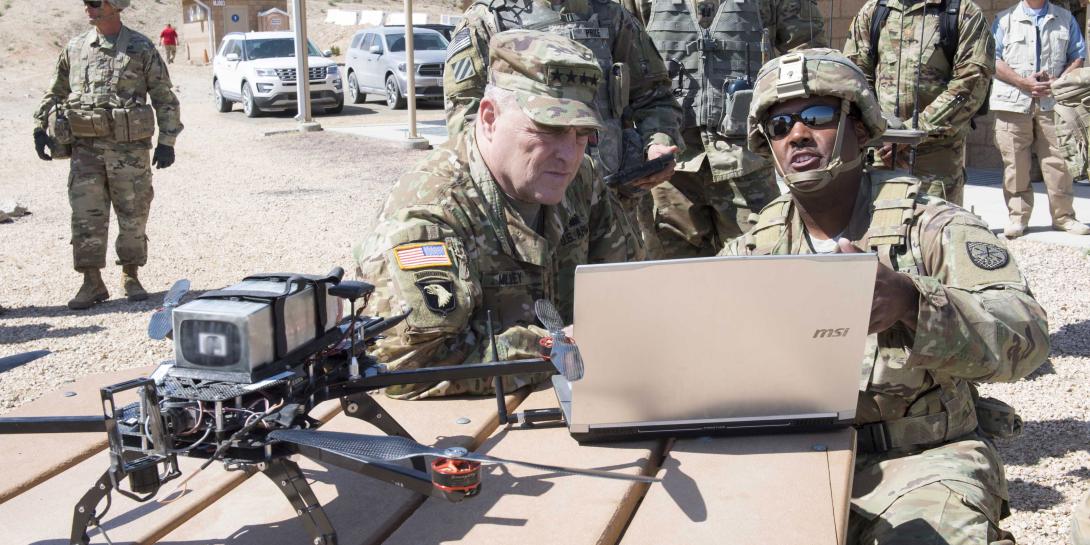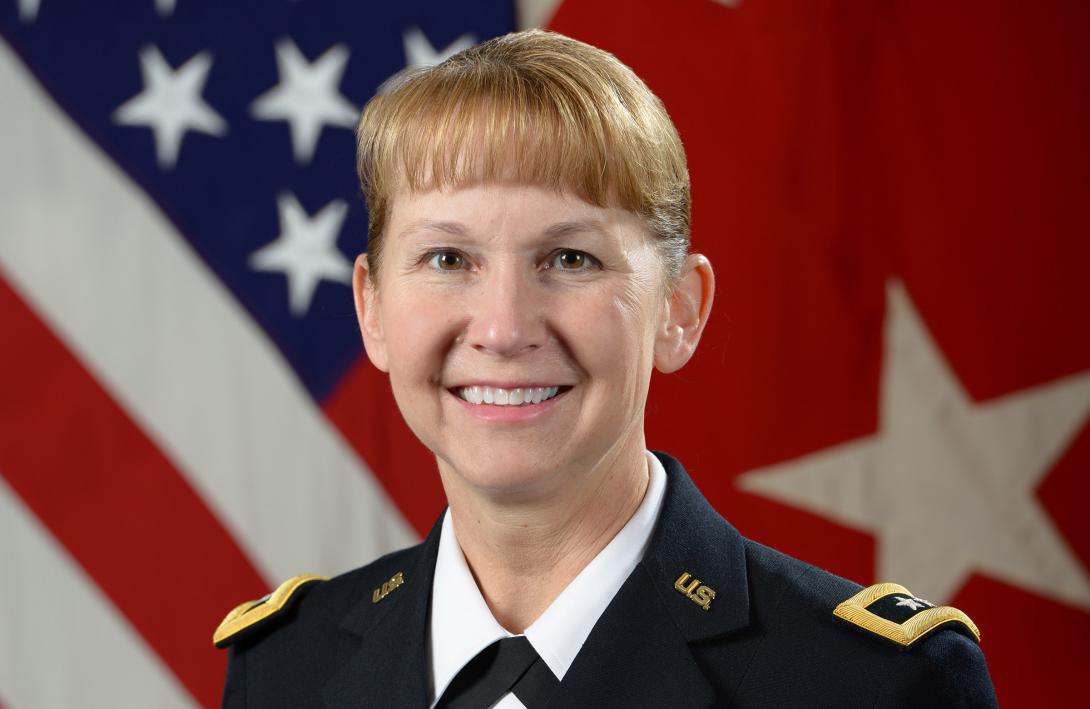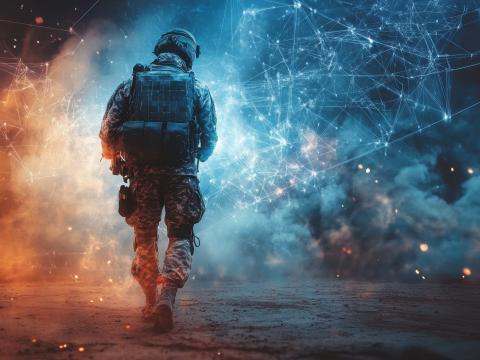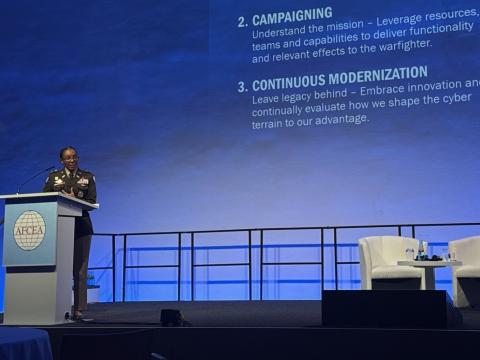Army Accelerates Cyber, EW Integration
The U.S. Army is serious about the narrative that it is serious about cyber. The service has put its organizational architecture on the line by prioritizing the newest warfighting domain while converging it with long-extant but re-emerging combat disciplines, a senior leader says.
A year ago this month, Army officials formed a new directorate within the Deputy Chief of Staff G-3/5/7 headquarters to lead the confluence of cybersecurity and electronic warfare (EW). Since then, they have made tangible progress in integrating cyber with signal, intelligence and EW to bring sharpened cyber offensive and defensive skills to the tactical edge to augment traditional maneuver forces, says Maj. Gen. Patricia Frost, USA, director of cyber within the Department of the Army’s Management Office (DAMO-CY).
From Gen. Frost’s office come the authorities, policies and resourcing requirements that enable Army Cyber Command and the service’s other major commands to defend networks, data, weapon systems and infrastructure, she says. The mission is one of many changes to sweep the Army as it works to curb cyber weaknesses and create a cultural shift that dovetails with removing the divides between the intelligence community and the Signal Corps, EW, cyber and information operations (IO), Gen. Frost says.
In April, the Army released an updated doctrine for cyber and EW functions, providing soldiers a field manual that details tactics and procedures for integrating the disciplines to support land and joint operations. “U.S. forces dominated cyberspace and the electromagnetic spectrum [EMS] in Afghanistan and Iraq against enemies and adversaries lacking the technical capabilities to challenge our superiority in cyberspace,” reads a portion of the manual. “However, regional peers have since demonstrated impressive capabilities in a hybrid operational environment that threatens the Army’s dominance in cyberspace and the EMS.”
Incorporating cyber electromagnetic activities (CEMA) throughout all phases of an operation ensures troops’ freedom of maneuver in cyberspace and the EMS while denying adversaries the same. “CEMA synchronizes capabilities across domains and warfighting functions and maximizes complementary effects in and through cyberspace and the EMS,” according to the field manual.
“In the future, we’ll try to bring in more space expertise because that’s really important in this field,” Gen. Frost adds.
Such cultural changes within an organization as large as the Army typically are neither easy nor welcome, she allows. But any discomfort linked to convergence is worth the nuisance. “If we look at future electronic warfare capabilities that we might want to field—well, there’s a dependency,” Gen. Frost says. “There’s a dependency on the network. There’s a dependency on data feeds. There’s a dependency on the intelligence that’s going to give you the threat information. You don’t want to just deploy a capability without thinking about the second- and third-order effects and the mission workload that you just put on another staff entity.”
The Army must approach cyber warfare the same way it does kinetic warfare, says Col. Tim Brooks, USA, director for the mission assurance section of the Cyber Directorate.
“The Army jumped on the cyber challenge in a big way, and it jumped on it fast,” Col. Brooks says. “We really went out of the gate to address the issues and get ahead of the ballgame.”
Fast might be relative, particularly in the shadow of the 10th anniversary of a series of major coordinated cyber attacks on Estonia. Officials have pegged the attacks against key Estonian government, financial and media sites to Russia.
But the landscape looked drastically different a decade ago, the general and the colonel agree. Back then, Col. Brooks was in Iraq’s Diyala province. “We weren’t fighting a massive cyberthreat over there. We were completely focused and fully engaged in two different fights,” he relates.
The focus then was on counterinsurgency operations in Afghanistan and Iraq, and cyberspace was neither contested nor congested, Gen. Frost says. “Our focus was exactly where it needed to be, and the Department of Defense had not felt that type of attack or intrusion as was felt in Estonia, or what we have seen in Ukraine,” she says, the latter referring to reports that Russia jammed Ukrainian communication systems in December 2015. “But we’re watching very, very carefully as the landscape has changed.”
The incidents in Estonia and Ukraine and the stream of cyber attacks on the U.S. government and private networks set the Army’s convergence plans in motion, Col. Brooks says. “We’ve taken a look at that, and I would argue the cyber directorate is here because we realized we had to look at things a different way,” he says.
Co-locating skilled midlevel to high-level soldiers trained in the diverse yet intertwined disciplines of cyber and EW breaks down barriers to improve cybersecurity, says Gen. Frost, who is building on her experiences as Army Cyber Command’s former deputy commanding general for operations.
Also, reaching out to the intelligence community helps operationalize the information it collects to paint a better picture about cyberthreats for battlefield commanders, Col. Brooks says. “We’re finding we have to get better on both sides. We’ve got to ask better questions of the intelligence community, and the intelligence community has to understand systems and functions better so that they know what to go looking for in the data,” he explains.
In May, the directorate launched Task Force Cyber Strong, which will strategically assess big Army’s cyber needs, strengths, weaknesses and assets in a thorough short-term review. “We’re getting the commands to ask themselves: How do you see yourself? What do you need to defend? How do you prioritize what needs to be defended? What do you look at hardening first? Where do you need to be resilient? Where do you need to have contingency operations?” Gen. Frost outlines.
From there, the directorate will fashion a methodology and a framework tailored to each command’s needs. “One of the unique things about the positioning here is that we can reach out to the operational community and help them see themselves better,” Col. Brooks says.
“We know how to maneuver our tanks across a muddy field,” he continues. “We know how to account for the effects of physical terrain. What we don’t yet understand or know how to seamlessly do is account for the virtual terrain. How do we protect weapon systems’ vulnerabilities, and how do we capitalize on weapon systems capabilities in the cyber terrain?”
Some of the answers undoubtedly will come when cyber-based technologies such as artificial intelligence and automation hit the market, Gen. Frost says.
“In the end, all of our efforts will make the Army a much more ready fighting force,” she says. “Standing up the directorate was really important as we go forward, and I think the directorate is enduring. I don’t see this as a flash. Cyberspace, as a domain, is here to stay.”







Comments